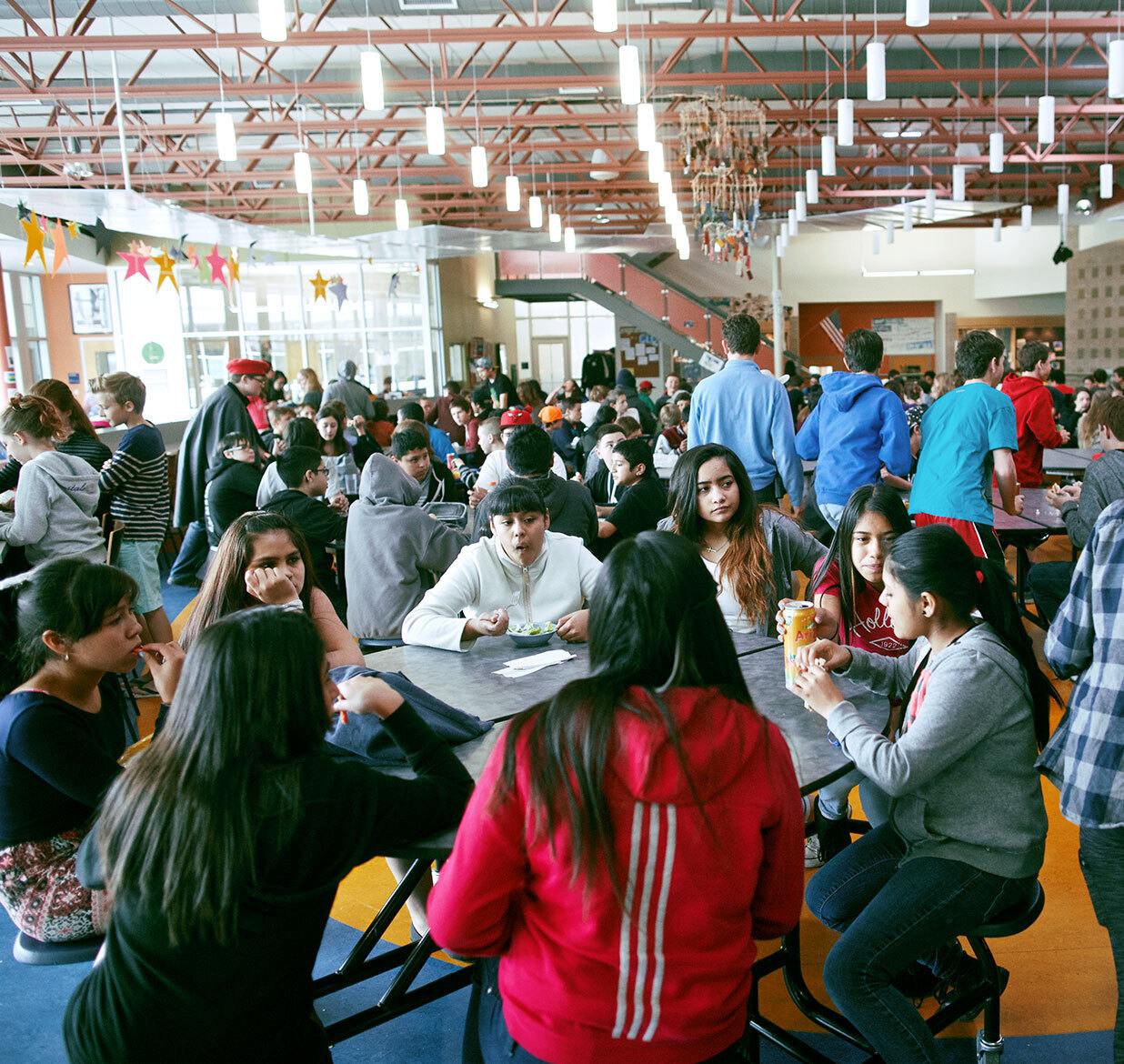
Step 3: Get Support
This section provides an overview of potential decision-makers for your school and/or district, tips on connecting with them to support your group’s efforts, and guidance on how to prepare for a district-wide meeting.
The School Food Advocacy Toolkit covers: Get Educated, Get Organized, Get Support (current page), Take Action.

Step 3: Get Support
This section provides an overview of potential decision-makers for your school and/or district, tips on connecting with them to support your group’s efforts, and guidance on how to prepare for a district-wide meeting.
The School Food Advocacy Toolkit covers: Get Educated, Get Organized, Get Support (current page), Take Action.
Connecting with Decision Makers
District Leaders & Key Influencers
Once you have goals, action steps, and programming suggestions, it’s time to present your ideas to the decision makers. It’s possible that representatives of the decision making bodies are already a part of your group (e.g. representatives from the school administration or board), and can act as ambassadors.
Even if this is the case, don’t count on your “in” to guarantee a receptive audience or approval. Be ready to respond to many different arguments as to why your ideas won’t work, and prepare answers to address them.
Ideally, key decision makers have already been made aware of your group and the work you’ve been doing through your ongoing communication and data-gathering activities. They should be anticipating a request for a meeting or presentation.

Create a presentation that you can use or modify for different decision making groups. A PowerPoint presentation can be ideal for communicating your group’s findings, goals, and recommendations clearly and concisely. The Center for Ecoliteracy’s guide for “Making the Case to School Leaders” may be helpful when putting together your presentation.

Make sure you understand the authority each decision maker has, and be clear about what you would like them to do. Let them know that you understand the policies and procedures surrounding the decision-making process at all levels.
Key Decision Makers & Ways to Engage Them
If the FSD has not been involved with your advocacy group, set up a meeting with them and present your findings, goals, and programming ideas. Invite their input and guidance before you ask for a meeting with school administration. Take the time to find points of agreement on priorities and ways to move forward. This will both avoid later conflicts and ensure that your group and the FSD are on the same page when you go to the administration. It’s a good idea to invite the FSD to your meeting with the administration.
An existing committee (e.g., the Student Health Advisory Council or SHAC) may already have school food in their purview and a set role in the administration. They may also have a relationship with the school board and may be able to help you develop a strategy for working with them. Set up a meeting with these existing committees to present on your advocacy group. Ask for feedback and guidance regarding moving change forward.
Set up a meeting with the administration (especially the school superintendent and the assistant superintendent of finance) and present your findings and recommendations. Let them know that you’ve met with the FSD. If there are areas where the advocacy group and the FSD disagree, be sure to let the administration know and look to them for support and guidance in resolving disagreements.
Get to know your school board and their priorities. Find places where your goals intersect. Try to find a champion who can help arrange a presentation to the board. During your presentation, be clear about what you would like the board to do, and be sure to involve a member of the administration when you present your case to the board.
While the PTO/PTA (Parent Teacher Organization/Parent Teacher Association) does not have the authority to make school policy changes, they are instrumental in gathering the community support needed to make such changes successful. You may want to modify your presentation to the PTO/PTA to address parents’ concerns, as these will not be the same as those of the administration and board. Again, be clear regarding what you are asking of the PTO/PTA. For example, using the PTO/PTA newsletter to communicate with parents about the school food changes the advocacy group is requesting.
Collaborative Responses to Common Concerns of Decision Makers
Keep in mind that school decision-makers are often doing the best they know how to do in their role as they work within a number of regulations, rules, and limitations. Due to the challenging environment that these decision-makers work in, you should be prepared for their possible resistance to programs that your advocacy group suggests. Remember that even if something they think is important is not important to you, it’s necessary to be responsive to them and find ways to compromise and/or collaborate to meet your advocacy group’s goals. Below are common concerns that parents and community members often hear with suggested responses to continue the conversation in a productive manner.


Collaborative Responses to Common Concerns of Decision Makers
Keep in mind that school decision-makers are often doing the best they know how to do in their role as they work within a number of regulations, rules, and limitations. Due to the challenging environment that these decision-makers work in, you should be prepared for their possible resistance to programs that your advocacy group suggests. Remember that even if something they think is important is not important to you, it’s necessary to be responsive to them and find ways to compromise and/or collaborate to meet your advocacy group’s goals. Below are common concerns that parents and community members often hear with suggested responses to continue the conversation in a productive manner.

Concern #1: The school food program lacks the money and/or resources to make any changes, to get rid of junk food sales, to incorporate fresh fruit, to buy more equipment, etc.
Response: There are grants available from Chef Ann Foundation, the USDA, and other non-governmental organizations that can help fund healthier school food, like the Fresh Fruit and Vegetable Grant and salad bar equipment grants.
Response: Junk food sales do more harm than good. Encouraging kids to develop poor eating habits has negative effects on academic performance, physical health, and development. School stores, vending machines, and group/athletic fundraisers can switch to healthy snacks, or they can sell fun items that promote school spirit, like t-shirts, pom-poms, and wristbands.
Concern #2: Kids don’t want to eat healthier food, so participation will go down and food waste will go up if we incorporate healthy food into the menus.
Response: I’ve read some studies that show that while there is usually an initial drop in participation following a change in menus, it goes up again over time when the quality of the food improves.


Concern #3: Schools can’t affect a child’s eating habits if they’re eating junk outside of school.
- Response: School is the place where children learn not just math and reading, but also social norms and eating habits, whether they are healthy or unhealthy. If kids are served pizza every day, they’ll learn that it’s okay to eat pizza every day. When children eat healthy food at school, they bring their knowledge home and into their future food choices.
Concern #4: The school food facilities aren’t equipped to handle changes.
Response: Some changes don’t require renovation. Things like placing healthier options in front of less-healthy options on the lunch line, or purchasing healthier options of the same foods, are easy to implement. For example, school food staff can place unflavored milk within hand’s reach and chocolate milk further away (or better yet, get rid of chocolate milk altogether).


Concern #5: Salad bars or breakfast-in-the-classroom (BIC) programs aren’t sanitary.
Response: Thousands of schools across the country have shown that even kindergarteners can learn basic salad bar hygiene practices, such as only handling the food with tongs, with some initial guidance from school food staff and volunteers. Sneeze guards have also proven effective in ensuring sanitation.
Response: Sanitation practices can be built into BIC, and students can help by removing the trash or wiping down their desks after eating.
Concern #6: Nutrition education activities, school gardens, and BIC take away from learning time.
Response: Nutrition education, school gardens, and BIC can be incorporated into math, science, social science, language-arts lesson plans and the core curriculum. Many school superintendents have issued memos declaring that breakfast in the classroom can be incorporated into instructional time.


Concern #7: Everyone expects school food to be bad. Parents who are concerned should pack lunches for their kids instead.
Response: At its heart, school lunch is a social justice issue. Not all families have the ability to pack a healthy school lunch every day for their children. In addition, one-third of our country’s children are overweight or obese, and another third face food insecurity. By providing a nutritious lunch for all students, you can help with health issues and food insecurity for many students.

Set Up a District Meeting
A district-wide meeting will be your rallying call to the community. You’ve conducted your research, determined priorities, figured out the strategies and action steps, explored programming possibilities, and engaged stakeholders and decision-makers. It’s time to go public with your work to educate and inspire the greater community. Here are some things to think about when planning your district-wide meeting:

Set Up a District Meeting
A district-wide meeting will be your rallying call to the community. You’ve conducted your research, determined priorities, figured out the strategies and action steps, explored programming possibilities, and engaged stakeholders and decision-makers. It’s time to go public with your work to educate and inspire the greater community. Here are some things to think about when planning your district-wide meeting:
Work with either the administration or school board to set up a presentation for the whole district. This public presentation may take place during a school board meeting.
Invite the Food Service Director and a representative from the school administration to be a part of the meeting. Give these individuals active roles. The administration and/or the school board may mandate the presence of certain representatives.
If the public presentation is not a school board meeting, work with the administration to book your meeting space well in advance. A school cafeteria is a great place to hold a meeting about school food, but other spaces will work as well.
Use multiple media and communication mechanisms to let the community know about the meeting. Ways to share information about the meeting include:
- District-wide newsletter
- PTO/PTA newsletter
- School announcements that go home with students
- Local public radio and television Public Service Announcements (PSAs)
- Media alerts to local newspapers, radio stations, and television stations
- Flyers and posters in schools, community businesses, and community centers
Consider offering healthy refreshments and childcare during the meeting in order to increase attendance. Make sure your communications to the public include the fact that these will be available.
Invite the school board, administrators, teachers, school staff, students, all district residents, and representatives from local government and municipalities.
Plan for the District-Wide Meeting
Before the Meeting
- Vary the speakers. It’s hard for an audience to maintain focus when one person talks the whole time.
- If the FSD and/or an administrator attend, make sure you provide them with the option to speak.
- Consider showing a brief video that introduces the current challenges that school food is facing, and why it’s important. Check out Talking About School Food with Chef Ann or any of the other videos on the Chef Ann Foundation’s YouTube channel.
- Include a variation of your PowerPoint presentation that you’ve adapted for your audience. Remember that for some people, school food may be an entirely new topic.
- Include your group’s goals and next steps. If the administration or the school board has already approved changes, make sure to mention that fact.
- Also include ways that attendees can get involved – give them a call to action. You can ask people to serve as liaisons for individual schools (ideally, there would be a liaison at every school in the district) or as subcommittee members of your advocacy group. Subcommittees can be charged with accomplishing a certain set of action steps, such as creating a cafeteria volunteer program.
- Create an agenda for the meeting and determine the speakers, topic, order, and allotted duration of each section. Below is a sample agenda outline. Plan for 60 minutes at most, and make sure to include at least 15 minutes at the end for Q&A and discussion. This may need to be abbreviated if your presentation is part of a school board meeting.
- Example Agenda
- Welcome and introductions (10 minutes)
- School administrator / FSD speak (5 minutes)
- Introductory video (10 minutes)
- Group presentation (15 minutes)
- Call to action (5 minutes)
- Q & A (15 minutes)
After the Meeting
- Follow-up after the meeting with the district, stakeholders and attendees.
- If the meeting doesn’t turn out as you had hoped, have your group brainstorm creative ways to increase awareness of school nutrition and to bring more attention to ways to improve your district’s school-food program.
- If your meeting had a positive outcome, focus on moving the decision-making forward.


After the Meeting
- Follow-up after the meeting with the district, stakeholders and attendees.
- If the meeting doesn’t turn out as you had hoped, have your group brainstorm creative ways to increase awareness of school nutrition and to bring more attention to ways to improve your district’s school-food program.
- If your meeting had a positive outcome, focus on moving the decision-making forward.
You’re ready for the next step!
Check out the Take Action section.
You’re ready for the next step!
Check out the Take Action section.







